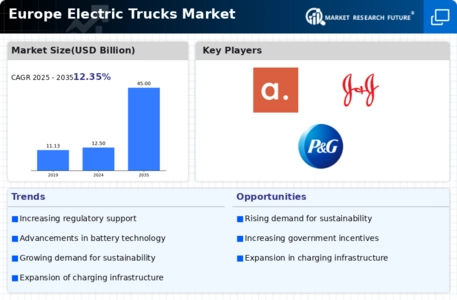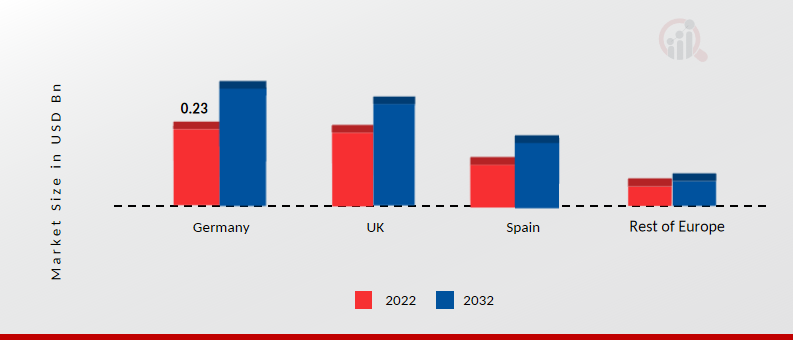Market Analysis
Europe Electric Trucks Market (Global, 2025)
Introduction
In Europe, the electric truck market is undergoing a major transformation as the region increasingly focuses on sustainable transportation solutions in response to stringent environmental regulations and growing demand for greener alternatives. With advances in battery technology, charging technology, and vehicle design, electric trucks are becoming viable for a wide range of applications, from city deliveries to long-distance logistics. Besides the pressure to reduce emissions, the shift to electric trucks is driven by the economic advantages of lower operating costs and maintenance. In this fast-moving market, as manufacturers continuously improve and expand their electric vehicle offerings, the competition is intensifying, new players are entering the market, and collaboration is increasing along the supply chain. These developments are both challenges and opportunities for the industry, which has to grapple with the complexities of market penetration, charging infrastructure, and acceptance in this rapidly changing industry.
PESTLE Analysis
- Political
- By 2025, the European Union intends to put in place new, more stringent, regulations requiring a minimum of a 55% reduction in greenhouse gas emissions by the year 2030, compared to the level of 1990. This political commitment will make it easier for the electric trucks to be accepted, as the European governments are putting in place a range of incentives to encourage the transition to zero-emission vehicles. For example, the European Commission has set aside about seven billion to develop the charging network and incentives for electric vehicles, and this will directly benefit the electric truck market.
- Economic
- The economic prospects for electric trucks in Europe are brighter because of considerable investment in green technology. In 2024 the European Investment Bank reported that some 30 billion euors were invested in the technology of electric vehicles on the continent. In addition, the cost of ownership of electric trucks is expected to be 20 per cent lower than that of diesel trucks in 2025, mainly because of lower fuel and maintenance costs, and this is expected to encourage fleet operators to change to electric trucks.
- Social
- Electrification of vehicles, including trucks, is increasingly viewed favorably by the public, and the survey shows that some seventy percent of Europeans are willing to pay a premium for such vehicles. The awareness of the role of transport in climate change is also growing. By 2025, it is expected that more than half of European logistics companies will have opted for electric trucks, which is a reflection of the growing concern for the environment among businesses.
- Technological
- It is therefore essential for the market for electric trucks that batteries continue to develop technologically. By 2025, the expected energy density of batteries is expected to be approximately 300 Wh/kg, which means a longer driving range and shorter charging times. Furthermore, the development of ultra-fast charging stations, which can supply up to 350 kW, will facilitate the widespread use of electric trucks and make them viable for long-distance transport.
- Legal
- The European Union's legal framework is increasingly supportive of the use of electric vehicles. By 2025, more than fifteen European countries are expected to have passed legislation banning the use of internal combustion engines by 2035. A supplementary incentive is the availability of tax breaks and subsidies on the purchase of electric trucks, with some countries offering up to ten thousand dollars per vehicle to encourage the electrification of their fleets.
- Environmental
- Electric trucks have been a key factor in the market for them. By 2025, the annual CO2 emissions from electric trucks in Europe are expected to be reduced by a total of about a million tons, which will contribute to the EU's climate goals. The transition to electric trucks will also reduce urban air pollution by 30 per cent in major cities, which will benefit public health and help the European Union achieve its Green Deal goals.
Porter's Five Forces
- Threat of New Entrants
- The European Electric Trucks Market in 2025 is expected to be moderately threatened by new entrants. The high capital costs of producing electric trucks and the market share of the established companies create a high barrier to market entry. However, new technology and supportive government policies will encourage new companies to enter the market.
- Bargaining Power of Suppliers
- The bargaining power of suppliers in the Europe Electric Trucks Market is expected to be low in 2025. The market is characterized by a large number of suppliers of batteries, electric drive trains, and other parts. The resulting diversity reduces the dependence of manufacturers on any one supplier and allows them to negotiate better prices and terms with them. Suppliers are also expected to face competition from a growing number of suppliers entering the market.
- Bargaining Power of Buyers
- The buyers in the Europe Electric Trucks Market will have a high bargaining power in 2025. The market will grow, and there will be more choices for consumers, and this will lead to a fierce competition among manufacturers. This competition will give the buyers the power to demand lower prices, better products and better services. The emphasis on the environment and the regulatory requirements will also make the buyers more cautious and increase their bargaining power.
- Threat of Substitutes
- The Threat of Substitutes in the European Electric Trucks Market Is Expected to Be Moderate in 2025. Despite the fact that electric trucks are becoming more popular due to their advantages in terms of the environment, diesel trucks and alternative fuel vehicles are still a threat to the market. The development of public transport and logistics solutions is also a threat to the market. However, the growing focus on reducing carbon emissions will over time reduce the attractiveness of substitutes.
- Competitive Rivalry
- Competition in the Europe Electric Trucks Market is anticipated to be high in 2025. There are a number of established players and new entrants who will be competing for the market share. The companies will have to rely on technological innovations, price, and after-sales services to differentiate themselves from the competition. The rapid pace of innovations and the need for sustainable solutions will make the market highly dynamic.
SWOT Analysis
Strengths
- Growing demand for sustainable transportation solutions.
- Strong government support and incentives for electric vehicle adoption.
- Advancements in battery technology enhancing range and efficiency.
- Established automotive manufacturers entering the electric truck segment.
- Increasing public awareness and preference for eco-friendly logistics.
Weaknesses
- High initial costs compared to traditional diesel trucks.
- Limited charging infrastructure in some regions.
- Range anxiety among potential users due to battery limitations.
- Longer refueling times compared to conventional fuel options.
- Dependence on government policies and subsidies for market growth.
Opportunities
- Expansion of charging networks and infrastructure development.
- Potential for partnerships with logistics companies for fleet electrification.
- Growing e-commerce sector driving demand for electric delivery vehicles.
- Technological innovations leading to improved vehicle performance.
- Increased focus on reducing carbon emissions in urban areas.
Threats
- Intense competition from established and emerging players in the market.
- Fluctuations in raw material prices affecting production costs.
- Regulatory changes that may impact market dynamics.
- Economic downturns affecting investment in electric vehicle technology.
- Public perception and acceptance challenges regarding electric trucks.
Summary
In 2025, the Europe electric truck market will be characterized by a number of significant strengths such as government support and technological advancements, which are driving the adoption of electric trucks. However, there are also challenges, such as high costs and limited charging and charging stations. Opportunities include the expansion of charging stations and the establishment of strategic alliances with transport companies. On the other hand, competition and macroeconomic fluctuations can also impact growth. A strategic focus on overcoming the weaknesses and utilizing the opportunities will be crucial for market participants.






Leave a Comment